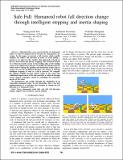Safe Fall: Humanoid robot fall direction change through intelligent stepping and inertia shaping
Author(s)
Yun, Seung-kook; Goswami, Ambarish; Sakagami, Yoshiaki
DownloadYun-2009-Safe Fall Humanoid robot fall direction change through intelligent stepping and inertia shaping.pdf (368.5Kb)
PUBLISHER_POLICY
Publisher Policy
Article is made available in accordance with the publisher's policy and may be subject to US copyright law. Please refer to the publisher's site for terms of use.
Terms of use
Metadata
Show full item recordAbstract
Although fall is a rare event in the life of a humanoid robot, we must be prepared for it because its consequences are serious. In this paper we present a fall strategy which rapidly modifies the robot's fall direction in order to avoid hitting a person or an object in the vicinity. Our approach is based on the key observation that during “toppling” the rotational motion of a robot necessarily occurs at the leading edge or the leading corner of its support base polygon. To modify the fall direction the robot needs to change the position and orientation of this edge or corner vis-a-vis the prohibited direction. We achieve it through intelligent stepping as soon as a fall is detected. We compute the optimal stepping location which results in the safest fall. Additional improvement to the fall controller is achieved through inertia shaping techniques aimed at controlling the centroidal inertia of the robot. We demonstrate our results through the simulation of an Asimo-like humanoid robot. To our knowledge, this is the first implementation of a controller that attempts to change the fall direction of a humanoid robot.
Date issued
2009-08Department
Massachusetts Institute of Technology. Computer Science and Artificial Intelligence LaboratoryJournal
Proceedings of the 2009 IEEE International Conference on Robotics and Automation
Publisher
Institute of Electrical and Electronics Engineers (IEEE)
Citation
Yun, Seung-kook, Ambarish Goswami, and Yoshiaki Sakagami. “Safe Fall: Humanoid Robot Fall Direction Change Through Intelligent Stepping and Inertia Shaping.” IEEE International Conference on Robotics and Automation (2009). 781–787. © 2012 IEEE
Version: Final published version
ISBN
978-1-4244-2788-8